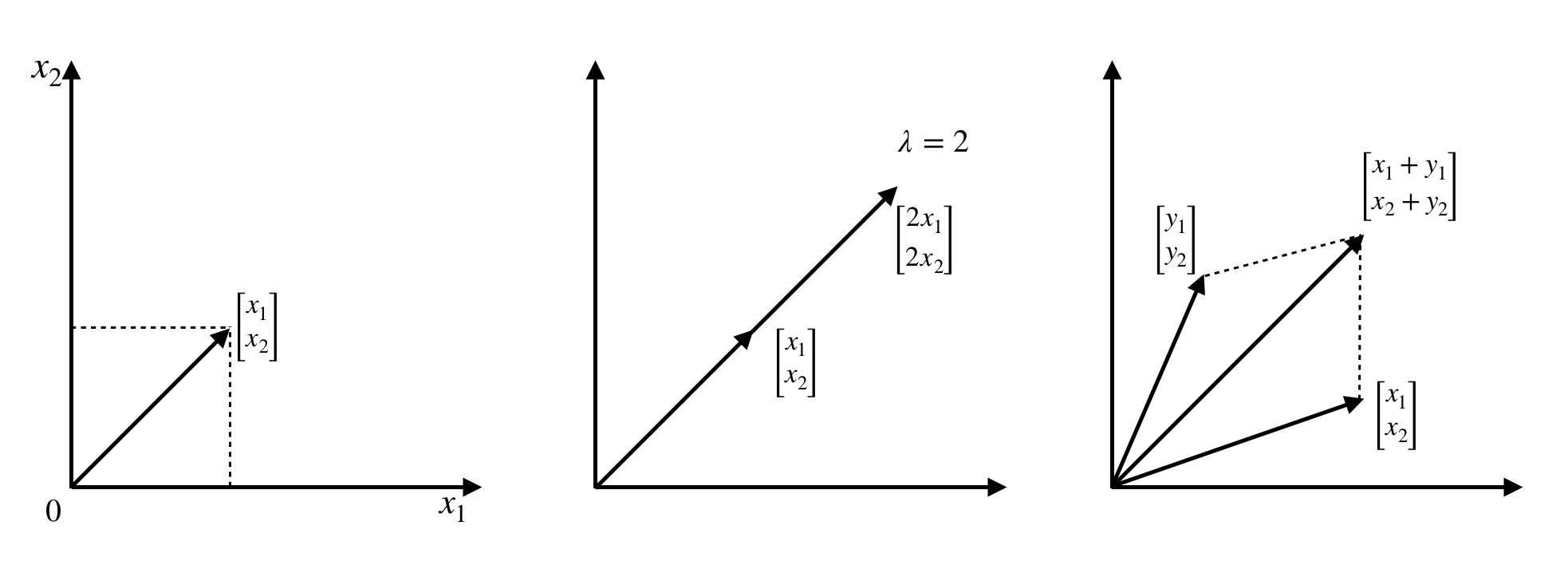One of the best ways to solve linear equations is by a systematic method known as elimination. This is a method that allows us to systematically eliminate variables and use substitution to solve equations.
Let's take a look at two equations with two variables, as follows:
After elimination, this becomes the following:
As we can see, the x variable is no longer in the second equation. We can plug the y value back into the first equation and solve for x. Doing this, we find that x = 3 and y = 1.
We call this triangular factorization. There are two types—lower triangular and upper triangular. We solve the upper triangular system from top to bottom using a process known as back substitution, and this works for systems of any size.
While this is an effective method, it is not fail-proof. We could come across a scenario where we have more equations than variables, or more variables than equations, which are unsolvable. Or, we could have a scenario such as 0x = 7, and, as we know, dividing by zero is impossible.
Let's solve three equations with three variables, as follows:
We will use upper triangular factorization and eliminate variables, starting with y and then z. Let's start by putting this into our matrix form, as follows:
For our purposes and to make things simpler, we will drop v, the column vector, and get the following result:
Then, exchange row 2 and row 3 with each other, like this:
Then, add row 2 and row 1 together to eliminate the first value in row 2, like this:
Next, multiply row 1 by 3/2 and subtract it from row 3, like this:
Finally, multiply row 2 by 6 and subtract it from row 3, like this:
As you can notice, the values in the matrix now form a triangle pointing upward, which is why we call it upper triangular. By substituting the values back into the previous equation backward (from bottom to top), we can solve, and find that  ,
,  , and
, and  .
.
In summary,  becomes
becomes  , as illustrated here:
, as illustrated here:
Note: The values across the diagonal in the triangular factorized matrix are called pivots, and when factorized, the values below the diagonal are all zeros.
To check that our found solution is right, we solve  , using our found values for x, y, and z, like this:
, using our found values for x, y, and z, like this:
This then becomes the following equation:
And as we can see, the left-hand side is equal to the right-hand side.
After upper triangular factorization, an arbitrary 4x4 matrix will look like this:
We could take this a step further and factorize the upper triangular matrix until we end up with a matrix that contains only the pivot values along the diagonal, and zeros everywhere else. This resulting matrix P essentially fully solves the problem for us without us having to resort to forward or backward substitution, and it looks like this:
But as you can tell, there are a lot of steps involved in getting us from A to P.
There is one other very important factorization method called lower-upper (LU) decomposition. The way it works is we factorize A into an upper triangular matrix U, and record the steps of Gaussian elimination in a lower triangular matrix L, such that  .
.
Let's revisit the matrix we upper-triangular factorized before and put it into LU factorized form, like this:
If we multiply the two matrices on the right, we will get the original matrix A. But how did we get here? Let's go through the steps, as follows:
- We start with
 , so that the following applies:
, so that the following applies:
- We add -1 to what was the identity matrix at l2,1 to represent the operation (row 2)-(-1)(row 1), so it becomes the following:
- We then add
 to the matrix at l3,1 to represent the
to the matrix at l3,1 to represent the  operation, so it becomes the following:
operation, so it becomes the following:
- We then add 6 to the matrix at l3,2 to represent the operation (row 3)-6(row 2), so it becomes the following:
This is the LU factorized matrix we saw earlier.
You might now be wondering what this has to do with solving  , which is very valid. The elimination process tends to work quite well, but we have to additionally apply all the operations we did on A to b as well, and this involves extra steps. However, LU factorization is only applied to A.
, which is very valid. The elimination process tends to work quite well, but we have to additionally apply all the operations we did on A to b as well, and this involves extra steps. However, LU factorization is only applied to A.
Let's now take a look at how we can solve our system of linear equations using this method.
For simplicity, we drop the variables vector and write A and b as follows:
But even this can get cumbersome to write as we go, so we will instead write it in the following way for further simplicity:
We then multiply both sides by  and get the following result:
and get the following result:
This tells us that  , and we already know from the preceding equation that
, and we already know from the preceding equation that  (so
(so  ). And by using back substitution, we can find the vector v.
). And by using back substitution, we can find the vector v.
In the preceding example, you may have noticed some new notation that I have not yet introduced, but not to worry—we will observe all the necessary notation and operations in the next section.























































 shows the vector is in n-dimensional real space, which results from taking the Cartesian product of
shows the vector is in n-dimensional real space, which results from taking the Cartesian product of  n times;
n times;  shows each element is a real number; i is the position of each element; and, finally,
shows each element is a real number; i is the position of each element; and, finally,  is a natural number, telling us how many elements are in the vector.
is a natural number, telling us how many elements are in the vector.  , so that the following applies:
, so that the following applies:
 in
in  , we reduce to 2-dimensions (for example, the surface of a sheet of paper), and when n = 3, we reduce to 3-dimensions (the real world).
, we reduce to 2-dimensions (for example, the surface of a sheet of paper), and when n = 3, we reduce to 3-dimensions (the real world).  , so that the following applies:
, so that the following applies:
 , and
, and  . Then, we have the following:
. Then, we have the following:
 , and
, and  . Then, we have the following:
. Then, we have the following:




 , where the column vector v is the variable vector. We write this as shown:
, where the column vector v is the variable vector. We write this as shown: .
. 



 (in 2-dimensional space), and all resulting combinations of these vectors will also be in
(in 2-dimensional space), and all resulting combinations of these vectors will also be in  . The same applies for vectors in
. The same applies for vectors in  ,
,  , and
, and  .
. , v and w, and find its dot product, like this:
, v and w, and find its dot product, like this:
 .
.

 , we write the x axis vector as
, we write the x axis vector as  and the y axis vector as
and the y axis vector as  . If we take the dot product i•j, we find that it is equal to zero, and they are thus perpendicular.
. If we take the dot product i•j, we find that it is equal to zero, and they are thus perpendicular. 







 . Since b is on the line and is a combination of the dependent vectors, there is an infinite number of solutions. We say that b is in the column space of A. While there is only one specific combination of v that produces b, there are infinite combinations of the column vectors that result in the zero vector (0). For example, for any value, a, we have the following:
. Since b is on the line and is a combination of the dependent vectors, there is an infinite number of solutions. We say that b is in the column space of A. While there is only one specific combination of v that produces b, there are infinite combinations of the column vectors that result in the zero vector (0). For example, for any value, a, we have the following:
 . We write this as
. We write this as  , where
, where  .
.
 .
. (equation 1) produces a plane, as do
(equation 1) produces a plane, as do  (equation 2), and
(equation 2), and  (equation 3).
(equation 3). , which is the solution to our problem.
, which is the solution to our problem.









 ,
,  , and
, and  .
. becomes
becomes  , as illustrated here:
, as illustrated here:
 , using our found values for x, y, and z, like this:
, using our found values for x, y, and z, like this:



 .
.
 , so that the following applies:
, so that the following applies:

 to the matrix at l3,1 to represent the
to the matrix at l3,1 to represent the  operation, so it becomes the following:
operation, so it becomes the following:

 , which is very valid. The elimination process tends to work quite well, but we have to additionally apply all the operations we did on A to b as well, and this involves extra steps. However, LU factorization is only applied to A.
, which is very valid. The elimination process tends to work quite well, but we have to additionally apply all the operations we did on A to b as well, and this involves extra steps. However, LU factorization is only applied to A. 
 and get the following result:
and get the following result:
 , and we already know from the preceding equation that
, and we already know from the preceding equation that  (so
(so  ). And by using back substitution, we can find the vector v.
). And by using back substitution, we can find the vector v. where we multiplied a matrix with a column vector, let's move on to dealing with the types of operations we can do with one or more matrices.
where we multiplied a matrix with a column vector, let's move on to dealing with the types of operations we can do with one or more matrices. matrices, A and B, and add them:
matrices, A and B, and add them:



 and
and 
 .
.


 or
or 


 (multiplying the matrix by itself p times)
(multiplying the matrix by itself p times) and
and  .
.
 so that
so that  .
. matrix A. If the matrix's transpose is B, then the dimensions of B are
matrix A. If the matrix's transpose is B, then the dimensions of B are  , such that:
, such that:  . Here is the matrix A:
. Here is the matrix A:
 .
.





 This matrix makes no change to the matrix it is applied on.
This matrix makes no change to the matrix it is applied on. This matrix swaps rows two and three of the matrix it is applied on.
This matrix swaps rows two and three of the matrix it is applied on. This matrix swaps rows one and two of the matrix it is applied on.
This matrix swaps rows one and two of the matrix it is applied on. This matrix shifts rows two and three up one and moves row one to the position of row three of the matrix it is applied on.
This matrix shifts rows two and three up one and moves row one to the position of row three of the matrix it is applied on. This matrix shifts rows one and two down one and moves row three to the row-one position of the matrix it is applied on.
This matrix shifts rows one and two down one and moves row three to the row-one position of the matrix it is applied on. This matrix swaps rows one and three of the matrix it is applied on.
This matrix swaps rows one and three of the matrix it is applied on. and it is invertible, then there exists a permutation matrix that when applied to A will give us the LU factor of A. We can express this like so:
and it is invertible, then there exists a permutation matrix that when applied to A will give us the LU factor of A. We can express this like so:
 , then
, then  .
.  is a straight line,
is a straight line,  is all the possible points in the xy-plane, and
is all the possible points in the xy-plane, and  is all the possible points in the xyz-plane—that is, 3-dimensional space, and so on.
is all the possible points in the xyz-plane—that is, 3-dimensional space, and so on. for all
for all  .
. , there exists an additive inverse such that
, there exists an additive inverse such that  .
. , there exists a multiplicative identity such that
, there exists a multiplicative identity such that  .
. ,
,  .
. .
. and
and  for all
for all  and for all
and for all  .
. , which implies that
, which implies that  .
. is the set of all linear combinations that can be made using the n vectors. Therefore,
is the set of all linear combinations that can be made using the n vectors. Therefore,  if the vectors are linearly independent and span V completely; then, the vectors
if the vectors are linearly independent and span V completely; then, the vectors  are the basis of V.
are the basis of V. . Then, S can only be a subspace if it follows the three rules, stated as follows:
. Then, S can only be a subspace if it follows the three rules, stated as follows:
 and
and  , which implies that S is closed under addition
, which implies that S is closed under addition and
and  so that
so that  , which implies that S is closed under scalar multiplication
, which implies that S is closed under scalar multiplication , then their sum is
, then their sum is  , where the result is also a subspace of V.
, where the result is also a subspace of V. is as follows:
is as follows:
 , where V and W are both vector spaces. They must satisfy the following criteria:
, where V and W are both vector spaces. They must satisfy the following criteria: , for all
, for all 
 , for all
, for all  and
and 
 , and they both have the same algebraic structure.
, and they both have the same algebraic structure. , and
, and  , then it is called a natural isomorphism. We write this as follows:
, then it is called a natural isomorphism. We write this as follows:
 and
and  are the bases of V
are the bases of V , which tells us that
, which tells us that  is an isomorphism.
is an isomorphism. 
 and
and  can be defined as follows:
can be defined as follows: .
. produces a linear map
produces a linear map  , which we write as
, which we write as  .
.
 such that
such that  .
. to
to  . The image, however, is the set of all possible linear combinations of
. The image, however, is the set of all possible linear combinations of  that can be mapped to the set of vectors
that can be mapped to the set of vectors  .
.  , the following will remain true:
, the following will remain true: .
. ). Metric spaces, however, needn't always be vector spaces. We use them because they allow us to define limits for objects besides real numbers.
). Metric spaces, however, needn't always be vector spaces. We use them because they allow us to define limits for objects besides real numbers. and satisfies the following criteria:
and satisfies the following criteria: , and when
, and when  then
then 

 (known as the triangle inequality)
(known as the triangle inequality) .
. and
and  ; then, the distance between them can be calculated as follows:
; then, the distance between them can be calculated as follows:
 , as follows:
, as follows:
 , and satisfies the following conditions:
, and satisfies the following conditions: , and when
, and when  then
then 

 (also known as the triangle inequality)
(also known as the triangle inequality) and
and 

 , as follows:
, as follows:


 (this applies
(this applies  )
) -norm, however, is a limit of the p-norm, as p tends to infinity.
-norm, however, is a limit of the p-norm, as p tends to infinity.
 , and satisfies the following rules:
, and satisfies the following rules:
 and
and 

 and
and  .
. 
 . As a shorthand for perpendicularity, we write
. As a shorthand for perpendicularity, we write  .
.  , then they are called orthonormal.
, then they are called orthonormal. is as follows:
is as follows:
 or
or  .
. 

 (only true when
(only true when  ), which produces 1, except with matrices. Therefore, AA-1 = I.
), which produces 1, except with matrices. Therefore, AA-1 = I.
 , and this resulting value is what we call the determinator.
, and this resulting value is what we call the determinator.


 . We then expand for all
. We then expand for all  , as follows:
, as follows:

 is a sub-matrix of
is a sub-matrix of  , which we get after removing row i and column j.
, which we get after removing row i and column j. 

 .
.




 whose vertices are formed by the column vectors in the matrix.
whose vertices are formed by the column vectors in the matrix.  with the vectors
with the vectors  and
and  . By taking the determinant of the 2
. By taking the determinant of the 2 or higher), as follows:
or higher), as follows:
 -dimensional vector is an eigenvector of A, and it corresponds to an eigenvalue λ. We write this as follows:
-dimensional vector is an eigenvector of A, and it corresponds to an eigenvalue λ. We write this as follows:
 , then it has the eigenvector x and the
, then it has the eigenvector x and the 

 .
. , with the corresponding eigenvalue
, with the corresponding eigenvalue  .
. for any
for any  .
.
 . And since this is equal to zero, this means it is a non-invertible matrix, and therefore its determinant too must be equal to zero. Using this, we can use the determinant to find the eigenvalues. Let's see how.
. And since this is equal to zero, this means it is a non-invertible matrix, and therefore its determinant too must be equal to zero. Using this, we can use the determinant to find the eigenvalues. Let's see how. . Then, its determinant is shown as follows:
. Then, its determinant is shown as follows:

 . So, we plug our values into the quadratic formula and get our roots.
. So, we plug our values into the quadratic formula and get our roots.





 . If they are orthogonal, then the following holds:
. If they are orthogonal, then the following holds: .
. with the following property:
with the following property:
 (that is, the transpose of Q is also the inverse of Q).
(that is, the transpose of Q is also the inverse of Q). .
.
 that has
that has  eigenvectors. We put these vectors into a matrix X that is invertible and multiply the two matrices. This gives us the following:
eigenvectors. We put these vectors into a matrix X that is invertible and multiply the two matrices. This gives us the following:
 that when dealing with matrices, this becomes
that when dealing with matrices, this becomes  , where
, where  and each xi has a unique λi. Therefore,
and each xi has a unique λi. Therefore,  .
. and for all
and for all  ,
,  . This may seem rather trivial, but its implications are rather strong.
. This may seem rather trivial, but its implications are rather strong. , which contains the eigenvectors of A.
, which contains the eigenvectors of A. and
and  for all
for all  ; therefore, we have the following:
; therefore, we have the following:
 s need to multiply the individual columns of Q.
s need to multiply the individual columns of Q.

 ,
,  ,
,  , and
, and  , and that U, V are orthogonal matrices, whereas ∑ is a matrix that contains singular values (denoted by σi) of A along the diagonal.
, and that U, V are orthogonal matrices, whereas ∑ is a matrix that contains singular values (denoted by σi) of A along the diagonal. 


 .
. ; therefore, we have the following:
; therefore, we have the following:


 , as follows:
, as follows:














